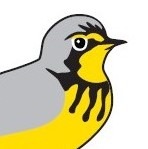By Jon McCracken, Director of National Programs, Bird Studies Canada

Eastern Meadowlark Photo: Ron Ridout
The federal government recently announced its long-awaited decision to legally designate eight more bird species under Canada’s Species at Risk Act (SARA). This brings the total number of bird species afforded special protection under SARA to 72. Three other species that had previously been assessed underwent scheduled 10-year reviews: Cerulean Warbler, Yellow-breasted Chat, and Hooded Warbler. The recent decisions are tabulated below.
As usual, most of the news is not good, though it’s noteworthy that the Hooded Warbler population in Canada has seen a dramatic increase since it was last assessed in 2000. This bird has gone from being Threatened to being no longer at risk. That’s good news.
What’s seldom reported is how much work goes into assigning a legal status under SARA. The process behind such decisions is long and involved.
First, the Committee on the Status of Endangered Wildlife in Canada (COSEWIC) commissions a detailed status report. These status reports are reviewed exhaustively, at a deeper level of peer review than papers aimed for publication in primary scientific literature. Before being tabled for a vote at a COSEWIC assessment meeting, the reports are vetted by at least 30 scientists during three stages of report production. From start to finish, the report writing and review process usually takes about two years.
COSEWIC then makes its recommendation to the federal Minister, but that’s just the beginning. Before a legal decision is made, the government consults with the public, internally deliberates, and obtains final approval, all of which takes several more years.
The whole process, from start to end, can take upwards of 10 years. That was the case for Bobolink, Eastern Meadowlark, and Barn Swallow – all of which are now protected as Threatened species under SARA.
Even then, it’s still not entirely over. For newly-listed species, it then takes several more years before federal Recovery Strategies or Management Plans are produced and accepted.
While we would all agree that it’s essential to get species assessments right, the current decision-making process takes an awfully long time. The small number of government staff who are charged with overseeing Canada’s species at risk process now have about 760 species on their plates. Investing in a larger staff complement would help expedite things.
Meanwhile, as years float by, the health of species being contemplated for recovery almost always gets worse. Like in a hospital setting, “long wait times” make the prospect for a patient’s recovery even more challenging than it already is.
Fortunately, others are concerned about this problem, and positive change may be on the horizon. Richard Cannings, MP for South Okanagan – West Kootenay, introduced a private member’s bill in September, which, if passed, would require the Minister of Environment to decide whether or not to list a given species within nine months of receiving COSEWIC’s recommendation. In November, Minister of Environment Catherine McKenna announced that the government would enact the proposal. We at Bird Studies Canada will be pleased if this indeed moves forward and speeds up the listing process to the benefit of Canada’s birds and other species at risk.
Jon McCracken served as co-chair of COSEWIC’s Birds Subcommittee from 2009 to 2016, inclusive. During that time, he helped shepherd all the species mentioned in this article through the assessment process.
Want to learn more about Species at Risk in Canada? Read about the most recent status decisions, or explore COSEWIC status reports.

* Species in bold were newly designated; those in normal typeface were regularly-scheduled reassessments from status designations assigned 10 or more years ago.

